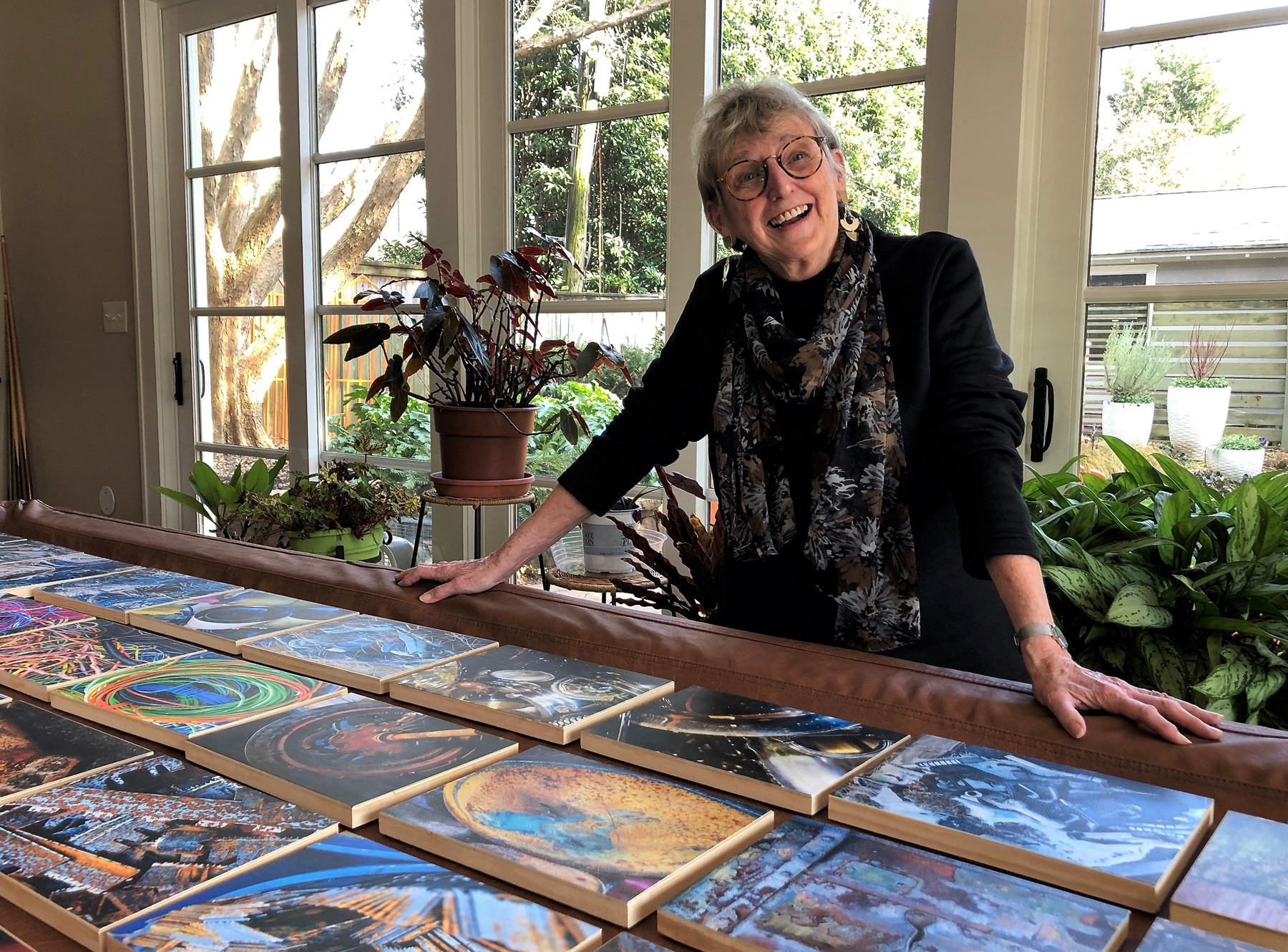ASC Grantee Nancy O. Albert Documents Places on the Verge of Disappearing

By Page Leggett
Photographer Nancy O. Albert focuses her attention, and her lens, on the transitory.
“It started in the 1980s when I lived in New England and began documenting textile mills and mill towns … a way of life that was disappearing,” said the photographer and 2023 Creative Mecklenburg Grant recipient. “Most of the mills were gone by the time I started photographing them.”
When she moved to Charlotte in 2006, she discovered that New England wasn’t the only region erasing its past. “I started doing a lot of research and began driving around,” she said. “That led to my big project – documenting tobacco barns. The ASC funded that, too. I’m very interested in things that are being lost.”
Albert has become a well-respected chronicler of changing landscapes. She’s been documenting Charlotte’s evolving eastside for years “without knowing where [the project] was going,” she said.
When she and photographer Lisa Howell scored shared studio space in the VAPA Center (they’d been on the waiting list for a year), it became clear what Albert should do with those photographs.
Howell has been documenting Charlotte’s changing landscape, too. Her focus is on Charlotte’s dwindling affordable housing, while Albert’s is on abandoned – or bulldozed – commercial buildings.
Once the duo told Joanne Rogers, director of the Nine Eighteen Nine Studio Gallery at the VAPA Center – and one of the founders of VAPA – about their complementary work, Rogers offered her gallery for an exhibition. “The Dignity of Memory” opens Thursday, Nov. 16 with a reception at 6 p.m. The exhibition will be on view through mid-December.
“Lisa is a wonderful photographer who’s focused on affordable housing,” Albert said. “That’s a big concern of mine, as well, but my photographs tend to be of commercial, human-scale neighborhood buildings. She’s looking at the human cost, and I’m looking at the emotional cost of loss of neighborhoods.”
How ASC made it happen

After years of shooting Charlotte’s eastside, Albert had accumulated a gallery’s worth of images.
What she didn’t have was a suitable way to print them. She requested funds – $2,250 – to purchase an Epson Sure Color P700 photo printer and was awarded the full amount.
“Because I prefer to have control over the photographic process from start to finish, I choose to print all my images myself,” she wrote in her application. “The printer I currently use, an Epson Stylus R2880, is nine years old. It saw me through the printing of 50 images for each of my two [ASC] Community-Supported Art projects and for all the work I have exhibited since then. But it has been refurbished once, and after so much printing, it is clearly on its last leg.”
Iván V. Garnica, ASC’s grants manager, was impressed with Albert’s application. “Nancy needed a printer,” he said. “That was a very specific ask. She told her story. Then, she highlighted an obstacle. And she outlined the difference this high-quality printer would make.”
Three panelists – all in the photography and visual arts realm – worked with Garnica to review applications. “The very first question we ask in the review process is: Should this proposal be funded?” he said. “And all three of them said an immediate yes to Nancy’s application. It was so thorough that there was no question we had that wasn’t answered in the proposal.”
One hundred fifty-five people applied for a Creative Mecklenburg grant last year, and ASC awarded grants to 72 of them. The panel’s decisions come down to three things, Garnica said:
- Creatives need to articulate the why behind what they do.
- Applicants should name an obstacle that’s preventing them from growing in their creative practice.
- There should be a clear way ASC can help stated in the application.
“A strong application walks me through what the artist is doing, why they’re doing it and how ASC funds can help bring their project to fruition,” Garnica said. “It all comes down to telling your story.”
Albert tells hers well. Her application included her mission: “While creating images to display and sell is important to every artist, I feel my most important mission … is to lovingly capture what is being lost, so there is visual record of places that once existed and were important to those who lived in them.”
She wasted no time in buying and setting up her printer. “I ordered it as soon as the grant money was available,” she said. “I have 30 11” x 14” color prints I did on the printer that are now framed and exhibition-ready. As an added bonus, Lisa was able to do all her printing on it, as well. She had never printed most of her work; it just existed digitally. So, it was doubly valuable to this show.”
Vanishing act
Albert’s application showed her passion for and knowledge of the neighborhoods she’s documented.
“Small businesses were prevalent – restaurants, neighborhood stores, barber and beauty shops and practical places catering to folks with modest incomes, like tire repair shops,” she wrote. “Many of these businesses were minority-owned and -run. Much of the affordable housing is threatened – bought up and demolished to make way for million-dollar homes and massive apartment complexes.”
By exhibiting her photographs, Albert hopes to raise awareness of disappearing neighborhoods, vanishing livelihoods. And she has even bigger plans.
She wrote: “I would like to eventually involve and collaborate with those who are similarly recording change: other VAPA artists, members of neighborhood associations and preservation organizations. This could evolve into an even larger, perhaps museum-sized exhibition.”
There’s already one collaboration that’s come about – and the exhibition hasn’t even opened. “John O’Connor, the director of the Robinson-Spangler Carolina Room – the public library’s archives of Charlotte history – will exhibit the work,” Albert said. The images will eventually be part of the library’s archives and available as a public record.
‘Repositories of memories’
Brookhill Village was developed for Black families in the 1950s in what’s now South End. Some families have called it home for several generations, but many have been displaced or anticipate displacement.
Albert’s and Howell’s images depict how “progress” is pushing long-time residents out of their homes and neighborhoods. The photographers believe “that every neighborhood and human dwelling is important to those who have lived there,” as they say in a press release. “They are repositories of memories and should be viewed with respect.”
Albert feels a sense of urgency about sharing these photos.
“Charlotte is changing incredibly fast,” she said. “The pace of change has sped up, too. There seems to be much more pressure for development along the east side and into NoDa. Apartment buildings are going up everywhere – soulless apartments, I might add.”
The changing landscape will be examined in depth on Saturday, Nov. 18 when Nine Eighteen Nine hosts a panel discussion including historian Dr. Tom Hanchett; a resident of the Brookhill community; and Michael Maxwell, a photographer with a studio at VAPA who grew up on Charlotte’s rapidly changing west side.
Change is inevitable. Nancy Albert’s recent work makes us think about how change occurs in the built environment and who’s being adversely affected by it. This is art that has a higher purpose.

